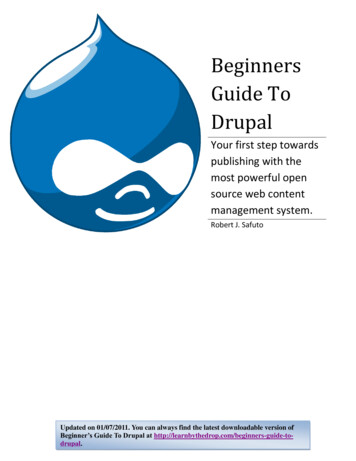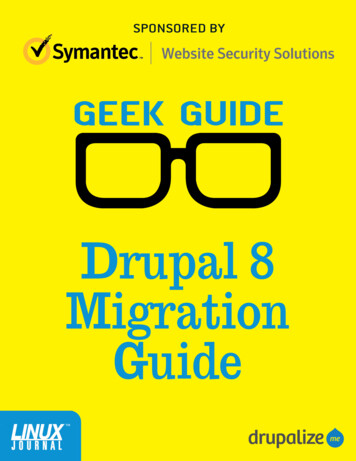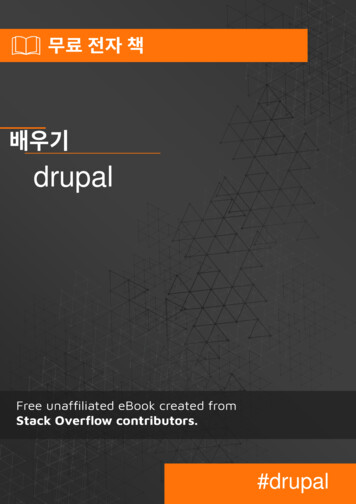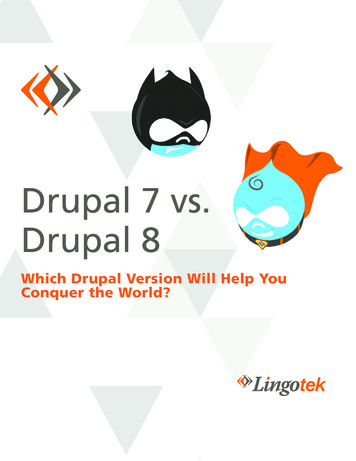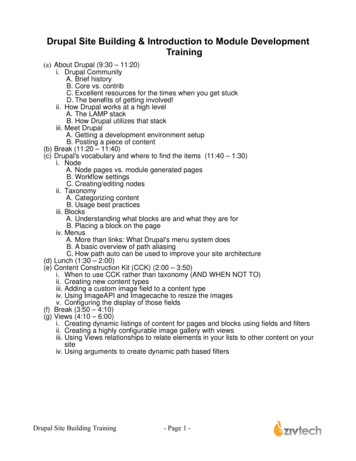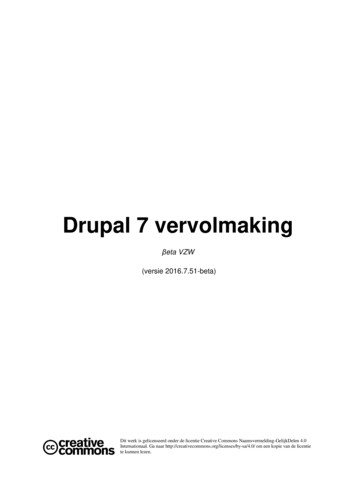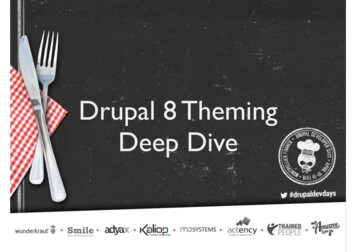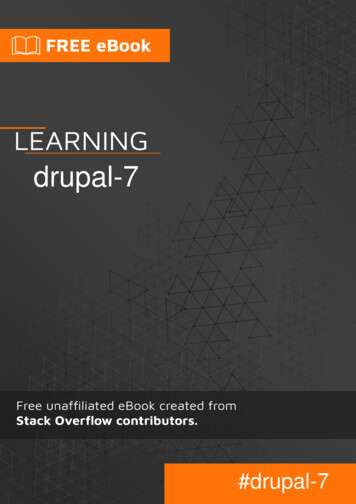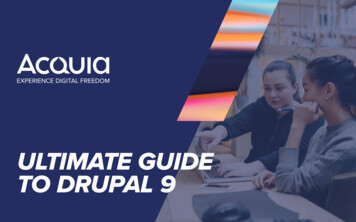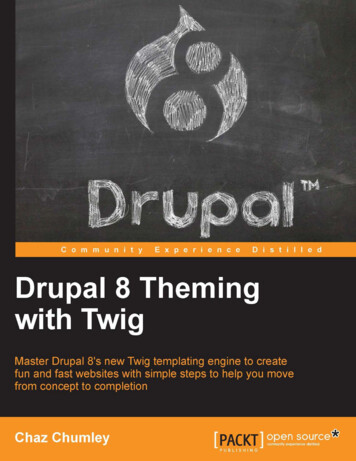
Transcription
Drupal 8 Theming with TwigMaster Drupal 8's new Twig templating engine to createfun and fast websites with simple steps to help youmove from concept to completionChaz ChumleyBIRMINGHAM - MUMBAI
Drupal 8 Theming with TwigCopyright 2016 Packt PublishingAll rights reserved. No part of this book may be reproduced, stored in a retrievalsystem, or transmitted in any form or by any means, without the prior writtenpermission of the publisher, except in the case of brief quotations embedded incritical articles or reviews.Every effort has been made in the preparation of this book to ensure the accuracyof the information presented. However, the information contained in this book issold without warranty, either express or implied. Neither the author, nor PacktPublishing, and its dealers and distributors will be held liable for any damagescaused or alleged to be caused directly or indirectly by this book.Packt Publishing has endeavored to provide trademark information about all of thecompanies and products mentioned in this book by the appropriate use of capitals.However, Packt Publishing cannot guarantee the accuracy of this information.First published: March 2016Production reference: 1170316Published by Packt Publishing Ltd.Livery Place35 Livery StreetBirmingham B3 2PB, UK.ISBN 978-1-78216-873-7www.packtpub.com
CreditsAuthorChaz ChumleyReviewerVincent LarkAcquisition EditorLarissa PintoContent Development EditorOnkar WaniTechnical EditorPramod KumavatCopy EditorDipti MankameProject CoordinatorBijal PatelProofreaderSafis EditingIndexerRekha NairGraphicsJason MonteiroProduction CoordinatorAparna BhagatCover WorkAparna Bhagat
About the AuthorEver since Chaz can remember, he has been picking up a crayon, a pencil, a pen, ora computer, whether to draw a picture, write a poem, share an article, or developthe next great website. Looking back at these qualities, it's the reason why he choseto use those passions to give back to the open source community. His journey hasopened doors to great experiences as a consultant, instructor, trainer, author, webdeveloper, technical architect, Drupalist, and most importantly, a father. However,he could be none of these without first being a student and learning from life, love,and a passion for education, community development, and of course, scienceand technology.The sum of these things has allowed Chaz to share his experiences as an activemember of the Drupal community, having participated in developing Lynda.comDrupal training videos, authoring multiple Drupal books for Packt Publishing, andgiving back his knowledge by contributing numerous articles and presentations atNYCCamp, BadCamp, and DrupalCon, and bringing top-notch Drupal expertiseto his clients' work.However, his greatest journey is still in front of him as he continues to learn newcreative ways to architect open source websites, write about the next best things,and laugh with his colleagues along the way.
AcknowledgmentsWhen I first started this journey of writing a Drupal 8 book, I thought to myself,"what could be so hard about that. Well, let me tell you?" Trying to catch up withevery Alpha, Beta, and Release candidate was like chasing that third grade crusharound the schoolyard. You were always able to catch her but then she wouldrun again.Speaking of crushes, I still have one on my beautiful wife. Without her even harderwork, dedication, and support, this book would have not been possible. The longhours and lost time cannot be made up, but her smile always fills my heart. She ismy friend, colleague in life, love, and spirit. Rebecca has allowed me to grow asan author and pursue the dream of putting my knowledge to pen and paper, eventhough she will tell you that I have been doing this for a while now ever since Iwrote her the first poem. Well honey, I hope you enjoy this latest poem becauseit's finally published.I also want to thank my two beautiful children, who while writing this book, havegrown up a little bit more. My son Brendan makes me proud every day to be hisfather and friend. He is a young man in his own mind but always my little buddy,quickly on his way to becoming an Eagle Scout. The other one is my daughter Kaylawho is getting ready to go off to college to pursue Graphic Design and just may writea book of her own some day. I definitely look forward to seeing you grow into thebeautiful woman you will be.I would like to thank Colin Panetta and Last Call Media for letting me use the greatDrupal 8 chalkboard for the book cover.I thank the Drupal community without whose support, I wouldn't be working withsuch an awesome content management framework.I have to thank my colleagues. There are too many to name but without theabsolutely great friends at Forum One I would have lost my mind writing thisbook: rock star developers, awe-inspiring designers, breathtaking UX, and amazingmarketing. Not only is it the best place I have ever worked, we are always hiring!
About the ReviewerVincent Lark is a French Full Stack developer with a strong web developmentbackground. After working on frontend and backend software in multiplecompanies, he's still very interested in every technical part of a product,especially on emergent technologies.When not coding for work, he also likes developing games as hobby in localgame jams.Vincent previously reviewed other books for Packt Publishing, includingLearning JavaScript Data Structures and Algorithms and WebGL Hotshot.
www.PacktPub.comeBooks, discount offers, and moreDid you know that Packt offers eBook versions of every book published, with PDFand ePub files available? You can upgrade to the eBook version at www.PacktPub.com and as a print book customer, you are entitled to a discount on the eBook copy.Get in touch with us at customercare@packtpub.com for more details.At www.PacktPub.com, you can also read a collection of free technical articles,sign up for a range of free newsletters and receive exclusive discounts and offerson Packt books and ion/packtlibDo you need instant solutions to your IT questions? PacktLib is Packt's online digitalbook library. Here, you can search, access, and read Packt's entire library of books.Why subscribe? Fully searchable across every book published by Packt Copy and paste, print, and bookmark content On demand and accessible via a web browser
Table of ContentsPrefaceChapter 1: Setting Up Our Development EnvironmentInstalling an AMP (Apache, MySQL, PHP) stackIntroducing MAMPDownloading MAMPInstalling MAMPA quick tour of MAMP PROGeneral settings for MAMP PROHost settingsInstalling Drupal 8Downloading Drupal 8Creating our document rootCreating our host entryxi122334567888Creating a new database for Drupal10Completing Drupal 8 installation13Reviewing the new admin interfaceExploring the admin menuPreviewing the interfaceExploring Drupal 8 folder structure20202126Using phpMyAdminChoosing a languageChoosing a profileVerifying requirementsDatabase configurationConfiguring the siteSite maintenance accountRegional settingsUpdate notifications111314141618191919The core folderThe modules folder2628[i]
Table of ContentsThe sites folderThe themes folder2930Using the project filesDownloading and extracting the exercise filesDatabase backup313131Database restoreUsing Google Chrome to inspect elementsSummary333335Export settingsChapter 2: Theme AdministrationWhat is a theme?Exploring the Appearance interfaceDrupal's core themesBartikSevenStarkClassyTheme statesInstalled themesUninstalled themesDefault themeInstalling and uninstalling themesStep one – installing a themeStep two – uninstalling a theme32373838393939393940404041414142Theme settingsToggling the display of page elementsLogo image settingsShortcut icon settingsTheme-specific settingsUsing prebuilt themesInstalling a new theme43434445464849Manually installing a themeCleaning up our themes folderManaging content with blocksExploring the Block layoutBlocks and regionsDemonstrating block regionsPlacing blocks into regionsConfiguring a block5456565657585960Installing from a URLUploading a module or theme archive to installManaging the title495161[ ii ]
Table of ContentsManaging visibility settings61Content types restrictionPage restrictionRole restriction626263Creating a custom blockManaging custom blocksExploring the custom block libraryExploring block typesManaging fieldsManaging displaySummary63666667687072Chapter 3: Dissecting a ThemeSetting up a local development environmentManaging sites/default folder permissionsConfiguring settings.local.phpDisabling CSS and JS aggregationDisabling render and page cacheDisabling test modules and themes73747474757576Default themes versus custom themesFolder structure and naming conventionsManaging configuration in Drupal 8Reviewing the new info.yml fileMetadataLibraries767677777878RegionsThe role of templates in DrupalHow templates workWhere to find templatesCreating our first basic themeStep One – creating a new folderStep two – create an info fileStep three – copy core templatesStep four – include a screenshotStep five – installing our themeStep six – Welcome to TwigIntroducing TwigEnabling Twig debugTwig fundamentals8283838587888888888989909091Defining a libraryAttaching a libraryCommenting variablesSetting variables79819192[ iii ]
Table of ContentsPrinting variablesDumping variablesFiltersControl structures92939496Template variablesThe role of the theme file in DrupalPreprocessors and hooksOverriding variablesSummaryChapter 4: Getting Started – Creating ThemesStarter themesCreating a Bootstrap starterUnderstanding grids and columnsSetting up a theme folderAdding a screenshotConfiguring our themeInstalling our themeWorking with librariesAdding assetsCreating a library referenceIncluding our 10111Creating a JumbotronStep one – managing block contentStep two – hiding the page titleRethinking our layoutAdding regionsManaging the block contentUsing Twig templatesCreating a homepage templateCreating region templatesWorking with the Theme layerUsing Devel to print sAdding the theme folderIncluding a screenshotConfiguring our themeInstalling our themeTouring ClassyOverriding a librarySummary126127127127127128129131Printing variables from a function[ iv ]124
Table of ContentsChapter 5: Prepping Our ProjectWalking through the design mockupHomepage layoutDefining homepage regions and user interactionBasic page layoutDefining interior regions133134134137138139Landing page layoutBlog detail layoutContact pageSearch resultsRestoring our database snapshotCreating a custom themeSetting up theme foldersAdding a screenshotCreating our configuration fileInstalling our themeSetting up our regionsSetting up our assetsAdding additional assetsHandling default filesSummaryChapter 6: Theming Our HomepageCreating our HTML wrapperIntroducing web fontsCreating our homepageUsing page templatesWorking with static contentImplementing our Header Top regionCreating our Social Icons blockInstalling Font Awesome libraryRefactoring Header Top regionImplementing our Header regionAdding a logoEnabling Site brandingPrinting our Header regionCreating Block templatesImplementing our search form blockPlacing our search form blockCreating a search form block templateAdding custom JavaScriptCreating an input element 8170170171172173
Table of ContentsWorking with menusCreating a menu templateCreating System Menu block templateCreating a sticky headerImplementing our Headline RegionCreating our Headline View and BlockAdding our Headlines BlockPrinting our Headline regionConfiguring FlexSlider libraryAttaching a library using TwigEnable FlexSliderImplementing ParallaxAdding a scroll effectEnabling the scroll scriptAttaching ScrollTo library using TwigImplementing our Before Content regionCreating our Services blockCreating our Features blockRefactoring Before Content regionImplementing the footerCreating our custom blocksRefactoring our main 6186186187188189189191Summary194Footer firstFooter secondFooter thirdFooter bottom leftFooter bottom rightChapter 7: Theming Our Interior PageReviewing the About Us mockupCreating our interior page templateAdding our Global HeaderImplementing our page titleWorking with static HTMLAdding new regionsReassigning the Page title blockPrinting the Title Bar regionCreating a block templateImplementing our main page structureCreating a Node template[ vi 06
Table of ContentsImplementing our Team members sectionPrepping our Team Member ViewCreating our Team Member ViewManaging our Team Members listing blockFormatting Views with CSSAdding CSS classes to ViewsUsing Twig variables to rewrite field contentRearranging View fieldsAdding a View headerRefactoring the After Content regionAdding our global footerFixing JavaScript errorsSummaryChapter 8: Theming Our Blog Listing PageReviewing the Blog Listing mockupCreating our blog listingAdding a new display modeManaging the displayEnabling fieldsField label visibilityFormatting fieldsCreating a Post Listing viewUsing Content Display modes with viewsManaging our Post Listing blockImplementing our Node templateAdding CSS classes to TwigWorking with content variablesUsing the without filterCreating our post image sliderWorking with field templatesAdding the Owl Carousel libraryUsing Twig filters for datesPrinting title and teaserCreating our post metadataField templates and taxonomyHandling comments in Drupal 8Creating a theme filePrinting our comment countAdding a read more linkCreating a Categories blockManaging our Categories block[ vii 246247248248250250251252
Table of ContentsImplementing responsive sidebarsTheming a Block templateDrupal Views and Twig templatesManaging popular versus recent contentCreating our recent posts blockCreating our popular posts blockSorting views by comment countAttaching a view to the footerManaging our popular posts blockUsing Twig and Bootstrap tabs253255256257257258259259260261Using Views-view templatesCreating a Post Teaser Twig templateAdding the About Us blockImplementing the About Us templateSummary262265266267269Recent Posts Twig templatePopular Posts Twig templateChapter 9: Theming Our Blog Detail PageReviewing the Blog detail mockupPreviewing our Blog detail pageCreating a Post Full templateAltering fieldsWorking with commentsIntroducing Comment typesReviewing Default Comment type fields and displayEnabling Post Type Comments fieldCreating a Field Comments templateTheming the Comment threadEnabling user photos for Comment threadsCleaning up the User Picture fieldCreating the Field User Picture 286287Date and time formatsImplementing social sharing capabilitiesThe Add This buttons288289290Summary293Creating a library entryAttaching the library to our Blog detail pageDisplaying buttons[ viii ]291291292
Table of ContentsChapter 10: Theming Our Contact Page295Chapter 11: Theming Our Search Results309Reviewing the contact page mockupIntroducing contact formsEditing a contact formManaging form fieldsManaging form displayContact page layoutAdding a Callout blockCreating the Callout block templateIntegrating Google Maps into our contact pageConfigure Google MapsCreating our Google Maps blockCreating the Callout Map templateSummaryReviewing the Search Results mockupLooking at default Search resultsIntroducing core searchIndexing contentEditing search pagesDisabling search pagesWorking with Search Results templatesModifying the item list templateCleaning up each resultSearch alternativesSearch APIInstalling the Search 2312313315315315317318318318Adding a serverAdding an index319321Creating a Search Results View323Using our search form328Configuring bundlesAdding fields to our index322322Using the Search index view modeAdding filter criteriaPlacing our exposed search formAdding our placeholder attribute324326327327Displaying the number of search resultsAdding a No Results message329330Summary332[ ix ]
Table of ContentsChapter 12: Tips, Tricks, and Where to Go from HereWorking with Local TasksTheming local tasksWorking with Status messagesAdding the Highlighted regionTheming our Status message block333334335336336337Reusing Twig templatesUsing extends to share layoutsWorking with Twig blocksWhere do we go from here?Summary338339339341342Index343[x]
PrefaceStarting from the bottom, Drupal 8 Theming with Twig will walk you through settingup and configuring a new Drupal 8 website. Navigate across the admin interface,learn how to work with core themes, and create new custom block layouts. Take areal-world project and create a Twig theme that adopts best practices to implementCSS frameworks and JavaScript libraries. See just how quick and easy it is to createbeautiful and responsive Drupal 8 websites along with avoiding some of the commonmistakes many frontend developers run into.If you consider yourself a frontend developer, you will be right at home. However,since no PHP knowledge will be necessary, anyone who can create HTML websiteswith basic HTML5 and CSS3 skills will learn how to create a great Drupal 8 theme.What this book coversChapter 1, Setting up Our Development Environment, will begin with walking youthrough setting up a development workflow. You will learn how to use an AMP(Apache, MySQL, PHP) stack to configure a local web server. We will introduce theprocess of installing Drupal 8 and walk through the admin interface in preparationfor working with the new Twig templating engine.Chapter 2, Theme Administration, provides a glance at the Appearance page, whereyou will learn how to install, uninstall, and configure various themes and settings.We will take a look at the new Block layout system as we explore how to add fieldsto blocks, reuse blocks, and assign chunks of content to various regions. Learn howDrupal 8 has reconfigured files and folders, where themes are now placed, and howto find core themes.[ xi ]
PrefaceChapter 3, Dissecting a Theme, begins with discussing the importance of a properdevelopment environment and the steps involved to ensure that you're ready forDrupal 8. This will help you learn the differences and similarities between core andcustom themes and how configuration has changed. Break down the metadata thatmakes up a theme, libraries, and regions. You will learn the role of templates andhow the theme layer interacts with the Twig templating engine.Chapter 4, Getting Started – Creating Themes, starts with creating a starter theme thatallows us to work with assets while learning common techniques to integrate variousCSS frameworks. You can learn how to rethink layout strategies as we dive into thetheme layer and work with Twig. Then, we will wrap up with creating a subthemethat extends the new Classy base theme.Chapter 5, Prepping Our Project, covers reviewing a real-world project that we will bebuilding and how to break down how design and functionality should come togetherin Drupal 8. We will create the new theme structure, define metadata, add regions,and implement several CSS and JavaScript libraries.Chapter 6, Theming Our Homepage, begins with working with the site branding blockto add a logo. We will create a basic HTML wrapper and homepage template usingTwig as we convert our homepage mockup into a fully functioning Drupal 8 frontpage. You will learn how to convert static markup into Twig variables as we themeglobal components, such as the Search block, menus, and custom blocks. Use the newlibraries.yml file to work with assets, such as Twitter Bootstrap and Flex Sliderand then attach them to specific templates using the new {{ attach library() }}function.Chapter 7, Theming Our Interior Page, will show you how to review mockups andidentify what regions, blocks, content types, and views will need to be developedto recreate functionality. You will learn how to reuse Drupal 8 regions, work withthe new Page title block, and how Twig plays an important part in rewritingViews output.Chapter 8, Theming Our Blog Listing Page, starts with the best practice approachesto managing content types. From adding new display modes to enabling andformatting fields, learn how to use content display modes with Views to displaydata in lieu of using fields directly. You can work with Node templates to addCSS classes directly to our markup, work with content variables, and learn howto suppress fields. You will use Twig filters to format dates and manage individualfield templates while creating a listing page.[ xii ]
PrefaceChapter 9, Theming Our Blog Detail Page, teaches us how to reuse Twig templates anddisplay different content simply by using file name suggestions to target-specificdisplay modes. You will work with the new comment types to add commentingfunctionality to pages as fields, learn how to alter comment display using fieldtemplates to theme comment threads, and add social sharing functionality to pagesusing custom blocks and JavaScript libraries that we can attach directly to a block.Chapter 10, Theming Our Contact Page, introduces contact forms in Drupal 8 that wecan use to create fieldable forms that users can interact with. You will learn how tointegrate Google Maps into custom blocks that take advantage of library assets andvendor JavaScript.Chapter 11, Theming Our Search Results, covers core search functionality, how toindex database content, and work with search results templates. Core search cansometimes be limited, so we will take a more advanced look at the Search APImodule to create a better search experience. You will learn how to add individualfields to search and use display modes to output content while creating a Searchview that allows us to expose filters to the users to find exactly what they arelooking for.Chapter 12, Tips, Tricks, and Where to Go from Here, introduces how to theme commonadmin sections of Drupal 8. You will learn how to modify the markup for localtasks and status messages. Reuse Twig templates using extends to share layoutswhile working with pages and blocks. Finally, we will leave you with some greatcontributed modules to take a look at and introduce you to the Drupal community.What you need for this bookTo follow along with this book, you need an installation of Drupal 8, preferablyin a local development environment located on a Windows, Mac, or Linux-basedcomputer. Documentation regarding setting up a local development environment canbe found at ronment.Specific system requirements are listed at https://www.drupal.org/requirements.An introduction to MAMP for Windows and Mac is also covered in Chapter 1, SettingUp Our Development Environment.To follow along with each lesson, you will need a text editor or IDE. To see a list ofsoftware to consider when developing in Drupal 8 you can refer to https://www.drupal.org/node/147789.[ xiii ]
PrefaceWho this book is forDrupal 8 Theming with Twig is intended for frontend developers, designers, andanyone who is generally interested in learning all the new features of Drupal 8theming. Discover what has changed from Drupal 7 to Drupal 8 and immerseyourself in the new Twig PHP templating engine. Familiarity with HTML5, CSS3,JavaScript, and the Drupal Admin interface would be helpful. Prior experience ofsetting up and configuring a standalone development environment is required aswe will be working with PHP and MySQL.ConventionsIn this book, you will find a number of text styles that distinguish between differentkinds of information. Here are some examples of these styles and an explanation oftheir meaning.Code words in text, database table names, folder names, filenames, file extensions,pathnames, dummy URLs, user input, and Twitter handles are shown as follows"Rename page.html.twig as page--front.html.twig.":A block of code is set as follows:name: Tweettype: themedescription: 'A Twitter Bootstrap starter theme'core: 8.xbase theme: falseNew terms and important words are shown in bold. Words that you see onthe screen, for example, in menus or dialog boxes, appear in the text like this:"Click on the Continue button, which will take us to the license information."Warnings or important notes appear in a box like this.Tips and tricks appear like this.[ xiv ]
PrefaceReader feedbackFeedback from our readers is always welcome. Let us know what you think aboutthis book—what you liked or disliked. Reader feedback is important for us as it helpsus develop titles that you will really get the most out of.To send us general feedback, simply e-mail feedback@packtpub.com, and mentionthe book's title in the subject of your message.If there is a topic that you have expertise in and you are interested in either writingor contributing to a book, see our author guide at www.packtpub.com/authors.Customer supportNow that you are the proud owner of a Packt book, we have a number of thingsto help you to get the most from your purchase. You can contact the author ith-twig if you arefacing a problem with any aspect of this book.Downloading the example codeYou can download the example code files for this book from your account athttp://www.packtpub.com. If you purchased this book elsewhere, you canvisit http://www.packtpub.com/support and register to have the files e-maileddirectly to you.You can download the code files by following these steps:1.2.3.4.5.6.7.Log in or register to our website using your e-mail address and password.Hover the mouse pointer on the SUPPORT tab at the top.Click on Code Downloads & Errata.Enter the name of the book in the Search box.Select the book for which you're looking to download the code files.Choose from the drop-down menu where you purchased this book from.Click on Code Download.Once the file is downloaded, please make sure that you unzip or extract the folderusing the latest version of: WinRAR / 7-Zip for Windows Zipeg / iZip / UnRarX for Mac 7-Zip / PeaZip for Linux[ xv ]
PrefaceErrataAlthough we have taken every care to ensure the accuracy of our content, mistakesdo happen. If you find a mistake in one of our books—maybe a mistake in the text orthe code—we would be grateful if you could report this to us. By doing so, you cansave other readers from frustration and help us improve subsequent versions of thisbook. If you find any errata, please report them by visiting http://www.packtpub.com/submit-errata, selecting your book, clicking on the Errata Submission Formlink, and entering the details of your errata. Once your errata are verified, yoursubmission will be accepted and the errata will be uploaded to our website or addedto any list of existing errata under the Errata section of that title.To view the previously submitted errata, go to https://www.packtpub.com/books/content/support and enter the name of the book in the search field. The requiredinformation will appear under the Errata section.PiracyPiracy of copyrighted material on the Internet is an ongoing problem across allmedia. At Packt, we take the protection of our copyright and licenses very seriously.If you come across any illegal copies of our works in any form on the Internet, pleaseprovide us with the location address or website name immediately so that we canpursue a remedy.Please contact us at copyright@packtpub.com with a link to the suspectedpirated material.We appreciate your help in protecting our authors and our ability to bring youvaluable content.QuestionsIf you have a problem with any aspect of this book, you can contact us atquestions@packtpub.com, and we will do our best to address the problem.[ xvi ]
Setting Up Our DevelopmentEnvironmentRegardless of you being a seasoned web developer or someone who is just aboutto start learning Drupal, there are few things that everybody needs to have in placebefore we can get started: First, is to make sure that we have an Application stack that will meet Drupal8's system requirements. MAMP provides us with a standalone web serverthat is generally referred to as an AMP (Apache, MySQL, PHP) stack andis available for both OS X and Windows. We will look at installing andconfiguring this local web server in preparation to install Drupal 8. Second, is to set up a Drupal 8 instance and learn the process of installingDrupal instances into our AMP stack. There are a few changes on how theconfiguration and installation processes work in Drupal 8, so we will takea closer look to ensure that we all begin development from the samestarting point. Third, we will be reviewing the Admin interface, including the newresponsive Admin menu and any configuration changes that have been madeas we navigate to familiar sections of our site. We will also look at how toextend our website using contributed modules, review changes to the filesand folder structure that make up Drupal 8, and discuss best practices tomanage your files. Finally, we will review the exercise files that we will be using throughoutthe series, including how to download and extract files, how to usephpMyAdmin—a database administration tool to back up and restoredatabase snapshots—and how to inspect elements within our HTMLstructure using Google Chrome.[1]
Setting Up Our Development EnvironmentLet's get started by installing our web environment that we will be using as we takean exciting look at Drupal 8 theming with Twig.Installing an AMP (Apache, MySQL, PHP)stackTo install and run Drupal 8, our server environment must meet and pass certainrequirements. These requirements include a web server (Apach
member of the Drupal community, having participated in developing Lynda.com Drupal training videos, authoring multiple Drupal books for Packt Publishing, and giving back his knowledge by contributing numerous articles and presentations at NYCCamp, BadCamp, and DrupalCon, and bringing top-notch Drupal expertise to his clients' work.
